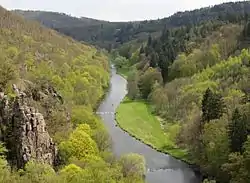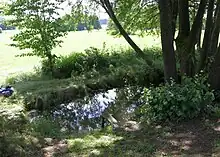Jihlava (river)
The Jihlava (Czech pronunciation: [ˈjɪɦlava] ⓘ; German: Igel) is a river in the Czech Republic, a right tributary of the Svratka River. It flows through the Vysočina and South Moravian regions. It is 180.8 km (112.3 mi) long, which makes it the 8th longest river in the Czech Republic.
| Jihlava | |
|---|---|
 The Jihlava at Lhánice | |
| Location | |
| Country | Czech Republic |
| Regions | |
| Physical characteristics | |
| Source | |
| • location | Jihlávka, Křemešník Highlands |
| • elevation | 666 m (2,185 ft) |
| Mouth | |
• location | Svratka |
• coordinates | 48°54′46″N 16°36′18″E |
• elevation | 169 m (554 ft) |
| Length | 180.8 km (112.3 mi) |
| Basin size | 2,996.5 km2 (1,157.0 sq mi) |
| Discharge | |
| • average | 12 m3/s (420 cu ft/s) near estuary |
| Basin features | |
| Progression | Svratka→ Thaya→ Morava→ Danube→ Black Sea |
Etymology
The first written mention of Jihlava (written as Giglaue) is from 1226, when it was referred to when demarcating the boundaries of the properties of the Želiv monastery.[1] The origin of the name is often interpreted as coming from the German igel (i.e. 'hedgehog'), but a more likely origin is the Celtic word uig, meaning 'stream'.[2]
Characteristic

The Jihlava originates in Jihlávka in the Křemešník Highlands at the elevation of 666 m (2,185 ft) and flows to the Nové Mlýny reservoirs, where it enters the Svratka River in Ivaň at the elevation of 169 m (554 ft). It is 180.8 km (112.3 mi) long, which makes it the 8th longest river in the Czech Republic. Its drainage basin has an area of 2,996.5 km2 (1,157.0 sq mi).[3]
The longest tributaries of the Jihlava are:
| Tributary | Length (km) | River km | Side |
|---|---|---|---|
| Oslava | 101.2 | 39.7 | left |
| Rokytná | 88.2 | 38.1 | right |
| Brtnice | 30.3 | 123.4 | right |
| Třešťský potok | 29.8 | 160.0 | right |
| Jihlávka | 25.7 | 142.6 | right |
Settlements
_-_%C3%BAst%C3%AD_%C5%99eky_Jihlavy_obr02.jpg.webp)
The most notable settlements on the river are the city of Jihlava, named after the river, and the town of Třebíč. The river flows through the following municipalities: Jihlávka, Horní Ves, Horní Cerekev, Batelov, Dolní Cerekev, Kostelec, Dvorce, Rantířov, Jihlava, Malý Beranov, Luka nad Jihlavou, Bítovčice, Bransouze, Číchov, Přibyslavice, Třebíč, Vladislav, Kramolín, Mohelno, Biskoupky, Ivančice, Moravské Bránice, Nové Bránice, Dolní Kounice, Pravlov, Kupařovice, Medlov, Pohořelice, Přibice and Ivaň.
Bodies of water
The reservoirs Dalešice (463 ha (1,140 acres)) and Mohelno (75 ha (190 acres)) are constructed on the river and are the largest bodies of water in the basin area. There are 2,666 bodies of water in the basin area.[3]
Economy
The Dalešice Hydro Power Plant is built on the river between the Dalešice and Mohelno reservoirs.
The Jihlava is suitable for river tourism. Three of its sections are navigable.[4][5]
References
- "Jihlava" (in Czech). Archaia Brno. Retrieved 2023-09-11.
- Svoboda, Jiří (2011-09-08). "O původu názvů českých řek" (in Czech). Archived from the original on 2020-10-25. Retrieved 2019-07-12.
- "Základní charakteristiky toku Jihlava a jeho povodí" (in Czech). T. G. Masaryk Water Research Institute. Retrieved 2023-09-11.
- "Řeka Jihlava – od Jihlávky až k Novým Mlýnům" (in Czech). CzechTourism. Retrieved 2023-09-11.
- "Jihlava – jedna z našich nejdelších řek" (in Czech). Pádler. 2017-11-09. Retrieved 2023-09-11.
External links
- River flow at Ivančice station – Flood Warning and Forecasting Service of the Czech Hydrometeorological Institute